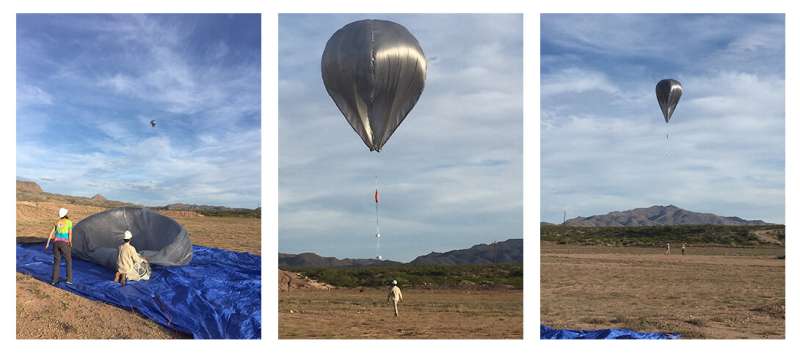Inflating a solar hot air balloon with an infrasound microbarometer payload. Credit: Darielle Dexheimer, Sandia National Laboratories.
Imagine if sending your science experiment 70,000 ft in the air just took painter's plastic, tape, a dash of charcoal dust, and plenty of sunlight.
Daniel Bowman of Sandia National Laboratories presented his findings using solar-powered hot air balloons to eavesdrop on stratospheric sounds at the 184th Meeting of the Acoustical Society of America on Thursday, May 11.
The stratosphere is a relatively calm layer of Earth's atmosphere. Rarely disturbed by planes or turbulence, microphones in the stratosphere pick up a variety of sounds unheard anywhere else. This includes natural sounds from colliding ocean waves and thunder, human-created sounds like wind turbines or explosions, and even sounds with unknown origins.
To reach the stratosphere, Bowman and his collaborators build balloons that span 6 to 7 meters across. Despite their large size and data collection capability, the balloons are relatively simple.
"Our balloons are basically giant plastic bags with some charcoal dust on the inside to make them dark. We build them using painter's plastic from the hardware store, shipping tape, and charcoal powder from pyrotechnic supply stores. When the sun shines on the dark balloons, the air inside heats up and becomes buoyant. This passive solar power is enough to bring the balloons from the surface to over 20 km (66,000 ft) in the sky," said Bowman. "Each balloon only needs about $50 worth of materials and can be built in a basketball court."
The researchers collect data and detect low-frequency sound with microbarometers, which were originally designed to monitor volcanoes. After releasing the balloons, they track their routes using GPS—a necessary task since the balloons sometimes sail for hundreds of miles and land in hard-to-reach places. But, because the balloons are inexpensive and easy to construct and launch, they can release a lot of balloons and collect more data.
Along with the expected human and environmental sounds, Bowman and his team detected something they are not able to identify.
"[In the stratosphere,] there are mysterious infrasound signals that occur a few times per hour on some flights, but the source of these is completely unknown," said Bowman.
Solar-powered balloons could also help explore other planets, such as observing Venus' seismic and volcanic activity through its thick atmosphere.
Provided by Acoustical Society of America
























